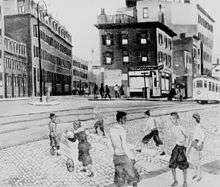Allan Crite
| Allan Rohan Crite | |
|---|---|
| Born |
March 20, 1910 North Plainfield, New Jersey, United States |
| Died |
September 6, 2007 (aged 97) Boston, Massachusetts, United States |
| Nationality | American |
| Alma mater |
School of the Museum of Fine Arts, Harvard Extension School |
| Awards | Harvard University Anniversary Medal |
Allan Rohan Crite (March 20, 1910[1] – September 6, 2007[1]) was a Boston-based artist born in North Plainfield, New Jersey. He won several honors, such as the 350th Harvard University Anniversary Medal.[2]
Personal life
Crite's mother, Annamae, was a poet who encouraged her son to draw. He showed promise early, enrolling in the Children's Art Centre at United South End Settlements in Boston and graduating from The English High School in 1929. Accepted at Yale, he instead went to the School of the Museum of Fine Arts, from which he graduated in 1936.[3]
Crite later decided to attend Harvard Extension School, where he completed his studies, receiving an ALB in 1968. He was also awarded an honorary doctorate from Suffolk University in Boston.[4]
Crite was among the few African-Americans ever employed by the Federal Arts Project. In 1940, he began a 30-year relationship with the Boston Naval Shipyard when he took a job as an engineering draftsman.[1]
During his later years, Crite both lived and worked in the Allan Rohan Crite Research Institute at 410 Columbus Avenue in Boston's South End.[2]
He died of natural causes in his sleep at age 97.[3][5]
Artwork

Crite was a devout Episcopalian, and his religion inspired many of his works.[6][7]
According to one biographer, his favorite color was "all colors" and his favorite time of year was "anything but winter."[1]
His paintings fall into two categories: religious themes and general African-American experiences with some reviewers adding a third category for work depicting Negro spirituals.[1] His 1946 painting Madonna of the Subway is an example of a blend of genres, depicting a Black Holy Mother and baby Jesus riding Boston's Orange Line.
Crite explained his body of work as having a common theme:
| “ | I've only done one piece of work in my whole life and I am still at it. I wanted to paint people of color as normal humans. I tell the story of man through the black figure.[5] | ” |
According to one reviewer, "Crite's oils and graphics, even when restricted to black and white, are bright in tonality, fine and varied in line, extremely rhythmic, dramatic in movement, and often patterned."[7]
Crite's works hang in such major American art galleries as the Smithsonian, the Museum of Fine Arts, Grossman Library, the Art Institute of Chicago, and the Boston Athenaeum, to which he left a substantial collection upon his death in gratitude for his long tenure there as a visiting artist and which now holds the largest public collection of his paintings and watercolors.
Books
Among Crite's illustrated books are 1948's Three Spirituals from Earth to Heaven, in which he illustrated religious stories from such African-American spirituals as Swing Low Sweet Chariot and Nobody Knows the Trouble I See.
Exhibitions
Crite's major exhibitions include 1920’s Harmon Foundation Exhibitions, 1930s Museum of Modern Art, New York, 1936 Corcoran Gallery of Art, Washington, D.C., 1939 Boston Museum of Fine Arts, 1978,The Boston Athenaeum, 1997, and the Frye Art Museum, Seattle, 2001.[6]
His works were shown in a coordinated series of posthumous exhibitions in 2007-08, at the Boston Public Library, the Boston Athenaeum, and the Museum of the National Center of Afro-American Artists.[8]
Notes
- 1 2 3 4 5 "Allan Crite Biography". The HistoryMakers. Retrieved 2008-03-20.
- 1 2 "Allan Crite at Home". Alumni Bulletin. Harvard Extension School. 1998. Archived from the original on April 21, 2008. Retrieved 2008-03-20.
- 1 2 Mark Feeney (2007-11-08). "Allan Rohan Crite, 97, dean of N.E. African-American artists". Boston Globe. Retrieved 2008-03-20..
- ↑ "Allan Rohan Crite Biography". Phillips Collection. Archived from the original on October 13, 2007. Retrieved 2008-03-20.
- 1 2 "Allan Rohan Crite". AskArt. Retrieved 2008-03-21.
- 1 2 "Allan Crite, an innovative painter". The African American Registry. Retrieved 2008-03-21.
- 1 2 "Allan Crite". Painters Biographies. 3D-Dali. Archived from the original on April 9, 2008. Retrieved 2008-03-21.
- ↑ "The life and art of Allan Rohan Crite: 1910-2007" (pdf). Boston Public Library. 2007-11-17. Retrieved 2008-03-21.